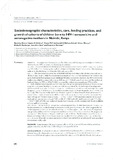| dc.contributor.author | Sherry, B | |
| dc.contributor.author | Embree, JE | |
| dc.contributor.author | Mei, Z | |
| dc.contributor.author | Ndinya-Achola Jeckoniah O. | |
| dc.contributor.author | Njenga, S | |
| dc.contributor.author | Muchunga, ER | |
| dc.date.accessioned | 2013-02-24T11:04:12Z | |
| dc.date.issued | 2000 | |
| dc.identifier.citation | Tropical Medicine and International Health | en |
| dc.identifier.uri | http://erepository.uonbi.ac.ke:8080/xmlui/handle/123456789/10983 | |
| dc.description | Sociodemographic characteristics, care, feeding practices, and growth of cohorts of children born to HIV-I seropositive and seronegative mothers in Nairobi, Kenya | en |
| dc.description.abstract | OBJECTIVES To compare sociodemographic profiles, child care, child feeding practices and growth indices of children born to HIV•l seropositive and seronegative mothers.
METHODS A cohort study of 234 children (seroposirive and seronegative) born to HIV-1 seropositive mothers and 139 children born to seronegative mothers in Pumwani Maternity Hospital which serves a low-income population in Nairobi, Kenya from December 1991 and January 1994.
RESULTS With few exceptions, at the time of their birth children in all three cohorts had parents with similar characteristics, lived in similar housing in similar geographical areas, had their mothers as their primary care givers, had similar feeding practices and similar growth status and patterns. However, the HIV-l seropositive mothers were slightly younger (23.8 years vs. 25.0 years, P < 0.01), if married they were less likely to be their husband's first wife (79% vs. 91%, P = 0.02) and more likely to have a one- room house (75% vs. 63%,
P = 0.04). All three cohorts had mean Z-scores in length-for-age and in weight-far-height within the normal range (:2: 2.0 Z-scores) from birth to 21 months with the exception of the length-for-age of the seropositive children at the 18-month visit. In all cohorts length-for-age became more compromised than weight-for-length, dropping to about -1.45 Z-score by 21 months; in contrast, weight-for-length dropped to about -0.5 Z-score by this age. The only statistically significant differences in growth indices among the three cohorts were be¬tween the two cohorts of seronegative children: rhose with seronegative morhers were less compromised 111 length-for-age at 1.5 months (mean Z-score = -0.19 us. -0.48, P < 0.05) and more compromised in weight¬for-length at 6 months (mean Z-score = 0.10 us. 0.45, P < 0.05) and at 18 months (mean Z-score = -0.73 us. -0.16, P < 0.05). 27-34% were exclusively breastfed at 1.5 months; 52-61% consumed solid foods in addition to breast milk by 2.5 months.
CONCLUSIONS Low-income HlV-iseroposirive- and seronegative-born children were from families with sinular characteristics and similar housing environments. Similar growth patterns in rhe cohorts suggest that the challenging environment and the choice of weaning foods had an impact on all three cohorts. The aggressive care given the children with HIV-l seropositive mothers and their children may have reduced the progression and impact of HIV-1 disease on the growth of the seropositive children. Further research is needed to corroborate our findings to be certain that our results are not affected by loss to follow- up bias: we lost the same proportion in all three cohorts bur cannot verify that the children we lost had the same growth patterns as those who remained in the study. | en |
| dc.description.uri | http://www.ncbi.nlm.nih.gov/pubmed/11044261 | |
| dc.language.iso | en | en |
| dc.publisher | Blackwell Science Ltd | en |
| dc.relation.ispartofseries | Tropical Medicine and International Health;volume 5 no 10 pp 678-686 october 2000 | |
| dc.subject | human immunodeficiency virus type 1, Kenya, children, parental characteristics, sociodemo¬graphic characteristics, child care, child feeding practices, growth indices | en |
| dc.title | Sociodemographic characteristics, care, feeding practices, and growth of cohorts of children born to HIV-I seropositive and seronegative mothers in Nairobi, Kenya | en |
| dc.type | Article | en |
| local.publisher | Department of Community Health, University of Nairobi, | en |
| local.publisher | Department oi Medical Microbiology, University of Nairobi, | en |
| local.publisher | Department of Medical Microbiology, University of Manitoba, Winnipeg, | en |
| local.publisher | Department of Epidemiology, Universit), of Washington, Seattle, | en |
| local.publisher | Maternal and Child Health Department, School of public Health, Tongji Medical University, Wuhan | en |

